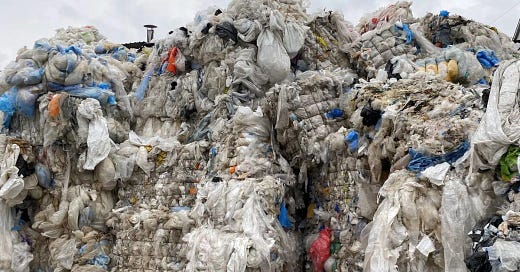The planet has a plastic problem.
We barely recycle it, it litters our parks and highways, spills into our waterways, and it’s full of harmful chemicals that turn toxic when burned.
China doesn’t want our contaminated plastic anymore (they banned plastic imports back in 2018), and so we ship our recyclables all over the world, pawning off our problem to lesser-developed nations.
Turkey has become one of the primary destinations for the world’s used-up plastics. But instead of actively trying to recycle it, a Greenpeace investigation back in 2021 uncovered that they were making money on the import then burning it all down.
Literally.
Not only were they burning mountains of plastic out in the open, they were straight up burning down their recycling facilities in an act of insurance fraud. Over 250 facility fires have been recorded since 2016. People have perished in the process.
This issue isn’t unique. The global infrastructure needed to effectively recycle the amount of plastic we throw away doesn’t exist. So it piles up, and up, and up.
And now it’s everywhere.
It’s in our food, it’s in our water, and it’s in our clothes.
I don’t necessarily have beef with putting plastic in our clothing as long as it’s recycled. But making new plastic just to put it in our clothes so brands can save a little money, well, I don’t love that.
Over the last few months, I’ve been slowly transitioning Fancy Groceries away from plastics wherever possible in an attempt to carry clothing made only of natural fibers like linen, hemp, wool, and organic cotton (with the exception of recycled plastics, but ultimately I’d like to avoid those too). It may not be much when it comes to curbing our plastic consumption, but it’s something.
In doing so, I’ve learned there are so many other fabrics in our clothing that can be difficult to identify.
Much like looking at the ingredients on the label when you shop at the grocery store, I think looking at the tag on your clothing to see what you’re really buying is also beneficial.
So here’s a quick guide to understanding what you might be seeing on your tag when you shop.
ACRYLIC: aka plexiglass. This is a plastic made out of petroleum, and a major cost-cutting tool in garment manufacturing. Wool and cotton blends are often full of the stuff, and its production bleeds carbon monoxide, carbon dioxide, and formaldehyd into the atmosphere. As a fabric, it barely absorbs water, making it difficult to clean, which leads to festering, order-causing bacteria in most acrylic garments. It is highly likely to pill (so don’t be fooled by expensive wool sweaters with acrylic blends) and while it won’t last long as a cardigan, it’ll stick around forever in a landfill. Oh, and it’s 🔥 highly flammable 🔥
To ensure you won’t spontaneously combust while at work, acrylic is usually doused in a flame retardant before it’s sewn into your clothes. Some people argue this retardant leaches into your skin, but I don’t know that to be true with certainty. What is true is that washing acrylic garments can release ten of thousands of micro-plastics into the waterways. What’s also true is that every time those microplastics shed from your clothes, so does the garment’s longevity and integrity.
The verdict: when possible, avoid purchasing new clothing with acrylic.
TENCEL: aka wood pulp. It’s all very scientific, but the gist is this - wood pulp is dissolved in a chemical solvent and pushed through a shower head-like device to form fiber strands, which can then be spun into yarns. What’s cool here is that the chemical process used to create Tencel is a closed-loop, recyclable system. Meaning none of the runoff is dumped into our waterways or released into the air. 99% of it is used again and again and again. But we do have to cut down trees to make it, which, as a self-proclaimed tree-hugger, I don’t love. My understanding is that Tencel manufacturers are strict about using responsibly sourced wood from tree plantations vs the rain forest, but unfortunately I can’t 100% confirm that. Another plus is that it requires half the dye that cotton does seeing as the final form of Tencel is pure white, so it doesn’t need to be bleached (something we often do to cotton and other fibers, sadly, to get great coloring in our clothes) and that too is a plus.
The verdict: this might be one of the lesser problematic alternative fibers.
VISCOSE/RAYON: aka Tencel’s evil twin. Similar to Tencel, Viscose is derived from “cellulose” or the wood pulp of fast-growing trees like pine or bamboo where it is then dissolved in a chemical solution called carbon disulfide, which is a powerful solvent that causes nausea, dizziness, difficulty to breathe, and hysteria in workers with short term exposure, as well as being linked to Parkinson’s and cancer in the long term. Just imagine all the towns and people living nearby these factories. The chemical process that creates viscose is excessive, dangerous, creates a ton of waste, and releases toxic chemicals into our waterways and air. Basically, the opposite of Tencel production, which, as mentioned above, is almost infinitely recyclable. Viscose is a highly processed, man-made fabric done cheaply, and has been identified as one of the drivers of illegal rainforest deforestation. Garments made of rayon or viscose tend to fade quickly, do not hold their shape, and often feel cheap and thin. I can’t really find any upsides to this fiber alternative.
The verdict: hell no.
NYLON: if you see ‘polyamide fabric’ on your care tag, it’s referring to nylon. Nylon is a catch-all for a group of plastics made of synthetic fibers. Nylon has its benefits - it is silky to the touch, and is often blended into wool garments in order to soften them. But nylon clothing does not hold up in the wash (it pills easily) and will melt at high temperatures. The manufacturing process of nylon releases nitrous oxide into the atmosphere, which tends to hang around for 120+ years, eroding the stratosphere, allowing more solar radiation than we need around here to seep through. Other greenhouse gases like carbon dioxide then trap the excessive solar radiation once it enters - heating things up.
Natural Clothing has a great illustration for the amount of energy it takes to make nylon fibers : it would take the energy of 250 elephants each weighing in at 1 tonne and each traveling at 99 mph to create just 2.2 lbs of nylon fiber. Needless to say, that’s a lot of energy and a little yield. Nylon is hard to avoid in our clothes. I try to consume it sparingly when I can, but one of my favorite jackets ever (a windbreaker, and I love a good windbreaker) is nylon. My favorite pair of jeans? They have 2% stretch.
I am not saying we have to stop buying and owning clothing with plastic in it. The financial and economic hurdles working against us are too high to achieve that. I think you should buy all the thrifted clothing containing polyester and acrylic that your heart desires. I have a shirt from the 70s that is 100% polyester. It is horrible to wear during the summer, but god I love it. Thrifting is a great way to keep plastics out of a landfill and/or becoming burnt.
And if you see something online or in store and you love it and it makes you happy when you put it on, then buy it! I own a 100% nylon jacket AND I still eat Oreo’s even though I can’t pronounce or identify half the ingredients.
I like to say “it’s not the poison, it’s the dose,” and I think that can be applied to our clothing consumption.
The idea here is to simply be more aware of what we’re purchasing, where it came from, who made it, and the effect it may have on us and others in the long run. Avoid plastics in your clothing when you can, especially if you’re making an investment purchase and you want it to last 5x as long.
At the end of the day, you can at least keep yourself from getting ripped off now that you know acrylic and viscose are terrible fabrics.











This is a class write-up